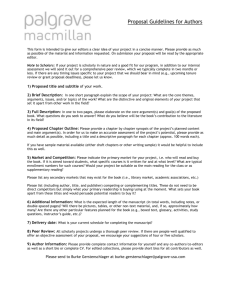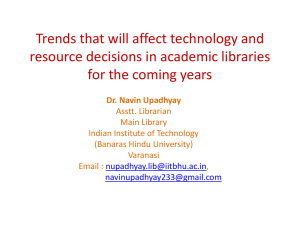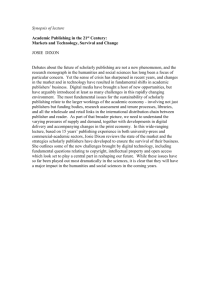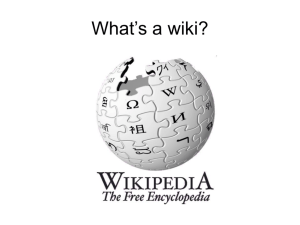Peer Production and Virtual Communities: Light and Heavy
advertisement
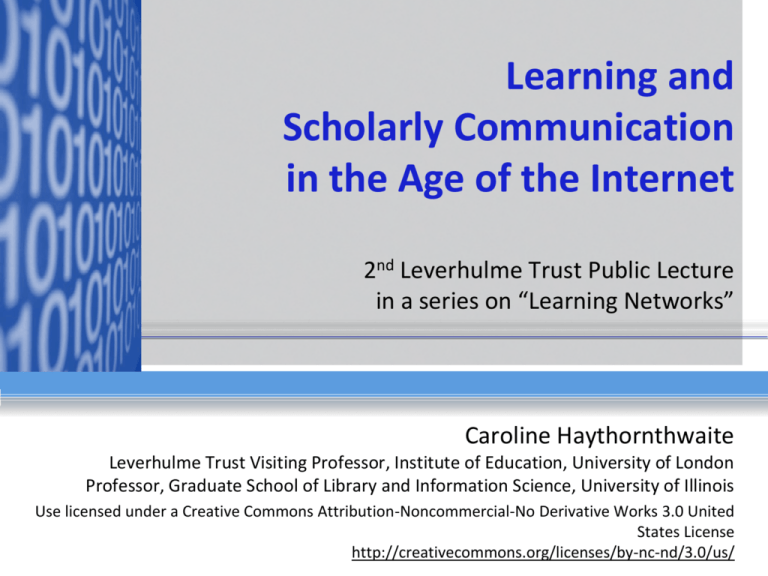
Learning and Scholarly Communication in the Age of the Internet 2nd Leverhulme Trust Public Lecture in a series on “Learning Networks” Caroline Haythornthwaite Leverhulme Trust Visiting Professor, Institute of Education, University of London Professor, Graduate School of Library and Information Science, University of Illinois Use licensed under a Creative Commons Attribution-Noncommercial-No Derivative Works 3.0 United States License http://creativecommons.org/licenses/by-nc-nd/3.0/us/ My Background and Interests • How do people work, learn and socialize together at a distance and through computer media? Communication, Collaboration, Community • Studies : Online Learning Networks Social networks / virtual communities Distributed learners / e-learning Collaborative research teams / distributed knowledge Peer production and knowledge communities Information sharing and learning / ubiquitous learning Leverhulme Trust series on Learning Networks Dec. 1, 2009 Learning in the age of Web 2.0 Feb. 4, 2010 Learning and scholarly communication in the age of the Internet Feb. 23 New theories and perspectives on learning in the digital age Mar. 11 Social networks and learning Mar. 30 Social informatics: E-learning as a socio-technical intervention tbd Ubiquitous learning Today’s Focus: Knowledge Sharing and Production • Two trends in Internet-based production Collaborative Peer Production Free/Libre Movement • Two parts to this talk Exploring the attributes of knowledge crowds in comparison to knowledge communities Examining scholarly communication and academic publishing as a “crowds-meets-community” example Collaborative Peer Production Crowd-Based From commons-based peer production to virtual communities Community-Based Free/Libre Movement • Open source, open science, open access, creative commons • Origins in Open Science Academic journal system University research dissemination • Free/Libre Open source/Free software movement (Richard Stallman) Free as in ‘free speech’ (not as in ‘free beer’) Free as in ‘Libre’ (not as in ‘Gratis’) Collaborative Peer Production + Free/Libre + Internet • Contributions No longer fixed, with an identifiable state, or provenance Mutable, updateable: Rapid, seamless, anonymous • Copyleft Right to use, change, redistribute granted as long as the product is also ‘copyleft’ • Creative Commons licensing Move beyond software to any production, and particularly those on the Internet • Open access Free as in ‘Gratis’ Scholarly Crowds and Communities • Much attention to knowledge communities Epistemic communities, discourse communites, communities of practice, communities of interest, affinity spaces • Turning now to attend to knowledge crowds Commons-based peer production, crowdsourcing • Both crowds and community are enabled by New and expanding online technologies Changing options and practices of online participation Creative commons copyright licensing Knowledge Crowds vs Knowledge Communities • Contrasting these two forms helps tease out the motivations of contributors to each, as well as to address what forms best address which knowledge activities How are these different kinds of knowledge initiatives organized? What distinguishes a successful, free-wheeling, online, crowdsourced knowledge collective from the formal dynamics of a knowledge community? How do crowds and communities support knowledge processes of learning, debate, data collection, analysis, dissemination and evaluation? Crowds and Communities • Community-based • Crowd-based Centralized effort by anonymous strangers, contributing to a common goal, with little expectation of persistence or continued commitment Similar others Known and continuously visible to each other Contributing to the community Expectation of persistence over time and continued commitment Lightweight to Heavyweight Crowd-based Lightweight Community-based Heavyweight CONTRIBUTIONS • Many, simple, discrete, unconnected CONTRIBUTIONS • Fewer, more complex, diverse, connected CONTRIBUTORS • Many, lightly-tied non-networked individuals CONTRIBUTORS • Fewer, heavily-tied, networked individuals … where ‘weight’ refers to the commitment and engagement with the production, not to the significance of the product itself Lightweight Peer Production • Distributed computing (use of Idle computer cycles) Berkeley Open Infrastructure for Network Computing (BOINC), e.g., SETI@home Hominid Fossil Venture NASA Clickworkers • Knowledge aggregators NASA Clickworkers, 23andWe (genomic info), Distributed proofreaders • Citizen science Biology sample collection, environmental monitoring, voluntary geographic info. • Collaborative tagging • Hybrids: crowd + community Wikipedia (talk pages), OpenStreetMap (talk pages) Heavyweight Peer Production • Open source projects • Communities of practice Linux, Wikipedia, Apache, OpenStreetMap Distributed teams and organizations • Blogging communities Slashdot, Digg, Livejournal • Learning communities Citizen journalism Communities of Inquiry E-Learning environments • Serious Leisure Collaborative learning communities Geo-caching; Last.fm • Academic disciplines • Gaming communities World of Warcraft Age of Mythology (Gee, 2005) Disciplines, fields, societies Exploring Differences and Dimensions • Dimensions of collaborative production Contributions Contributors Learning and Commitment Recognition, Reputation and Reward Authority and Control Motivations and Coorientation Contributions Lightweight • Many, small, similar • Independent • Assessment • Quantitative • Automated • Address problems of ‘uncertainty’ NB. Light and heavy in the following slides represent idealized ends of a continuum Heavyweight • Diverse, small to large • Interdependent • Assessment • Qualitative • Human • Addresses problems of ‘equivocality’ Contributors Lightweight • Many, undifferentiated • Little to no training • Social network ties weak or non-existent • Actions coordinated by overall authority • Attention given to quantity Heavyweight • Select, differentiated • Need training or expertise • Social network ties strong among core actors • Actions coordinated by group decision • Attention given to quality, and to who is judging Contributor Networks • Communities depend on strong-tie core But, they also include weak tie periphery Lurkers, newbies, future central actors • Crowds depend on weak-tie numbers and reach But, peer productions are “latent tie” structures on which ties may form, generating community-like traits E.g., attention to ranking of quantity of contributions Creating communities among crowd-sourced projects E.g., in the ‘talk’ pages of wikis Learning and Commitment Lightweight Heavyweight • Learning • Learning What and how to contribute; community practices, structures, roles Minimal instruction needed to contribute • Time to complete task Limited, one-shot Each contribution dealt with separately • Membership • Time to complete task Ongoing, revised, re-evaluated Contributions evaluated collectively • Membership Limited, gated, qualified, apprenticed, role specific Easy entry and exit • Commitment • Commitment Task oriented, Low overhead to start; no obligation to stay To task, group, overall project goals, to learning norms and about others Recognition, Reputation, Reward Lightweight • Quantitative Evaluation Heavyweight • Qualitative Evaluation Automated count of contribution Undifferentiated, easily automated, amenable to statistical evaluation • Contributor reward and reputation Based on count of contributions Easily aggregated automatically Signalled by instrumental quantitative rankings • Evaluator status does not matter Human judgement of quality, relevance, importance Reflects community values Differentiated, variable, not easily automated • Contributor reward and reputation Based on judgements by others, according to community values Signalled with differentiated, personal awards and recognitions Community-centric rewards/awards • Evaluator status matters Authority and Control: Enterprises of Coordination and Collaboration Lightweight (Coordination) • Centralized authority Heavyweight (Collaboration) • Distributed, community-based • Control by the designer / director • Control by core and community Weakly tied contributors do not have established means to communicate and coordinate • Consensus Can be managed by statistical processing Strongly tied contributors can coordinate to effect outcomes, including changes in practices • Consensus Managed through conversation, argument, adherence to norms (e.g., wiki ‘talk’ pages, FAQs) Motivations and Coorientation Personal • Stimulation, entertainment • Interest for work, learning and/or play • Self-promotion, career promotion ‘Personal but shared need’ (Raymond, Benkler) “They may be teachers, parents, academics, or hobbyists, but they are all likely to be unusually committed as a common project to producing materials that are useful to teachers and students.” Shared (internal) • Shared with community • Social presence • being there with others • Attention to others’ opinion of own work Shared (external) • Coorientation to topic, longrange goals, method or philosopy of production (e.g., open access) • Trust in use of contribution, the ‘social contract’ Personal but Shared • Re voluntary OpenStreetMap data being provided to Google during the Haiti crisis • Yes, I generally don't want to just give my data to Google without getting anything back and so yes I am a strong supporter of a share-alike license normally. But the reason I want a share-alike license is because I don't want to work for free and want to get paid for my work. Not with money but normally with more data. However here in Haiti, my payment would be that this work might save lives or at least help make it less devestating for some. This is more than Google can ever give back! [Comment from amm at Fri, 22 Jan 2010 23:10:28 +0000; emphasis added; • http://www.openstreetmap.org/user/Harry%20Wood/diary/9332 Retrieved Feb. 4 2010 • For more on OpenStreetMap, see Muki Haklay’s blog: http://povesham.wordpress.com Social Contract • Academia Perceived defection of publishers from disseminating knowledge – in synch with shared interest of academics – to making money • Don’t Buy That Textbook, Download It Free. (NY Times) Economics professor puts text online because “This market is not working very well except for the shareholders in the textbook publishers,” he said. “We have lots of knowledge, but we are not getting it out.” http://www.nytimes.com/2008/09/15/technology/15link.html?_r=1&emc=tnt&t ntemail1=y&oref=slogin Summary: Lightweight & Heavyweight Lightweight Heavyweight • Contributions are similar, require little learning or effort • Weak or no association between contributions • Minimal commitment to belonging and continuing • Weak or no ties between contributors • Contributors have coorientation to overall goals • External authority and control • Evaluation based on quantity of contributions • Errors handled by quantity and statistical averaging • Contributions differ, require learning, continued effort • Strong interconnection between contributions • Commitment to belonging and staying • Strong ties to community members • Strong coorientation to goals, product AND to community members • Internal authority and control • Evaluation of quality of contributions, and of contributors • Errors handled by contributor vigilance Academic Production in the Age of the Internet • Crowds-meetscommunity example • A heavyweight knowledge community meets a lightweight production challenge Academic Production: Heavyweight • Strong internal disciplinary conventions Subject, writing and methodology conventions • Strongly tied, mutually visible peers Disciplinary standards for tenure, promotion Disciplinary rankings of journals Peer review of publications, grants Recognizable accreditation and ranking of individuals and institutions • Long-term commitment to disciplinary knowledge Apprenticeships, promotions, journals Scholarly Publishing: Personal but shared interests Personal Shared (internal) • Tenure, promotion • Personal recognition • Economic and career survival (Publish or perish) • Colleagues, academic department, discipline, university • Professional organizations, conferences, journals • Methodology and publishing conventions Shared (external) • Institutional • University, Library, Students • Public • Knowledge, Education, Society Academic Calculus: Where to publish? • What’s the prestige value of the resulting publication? to my institution, colleagues, discipline, scholarly community, tenure committee • What is the likely timeframe? (1) review, (2) decision on acceptance, (3) appearance in print or online How much time do I have? • What is the likelihood of • Will anyone find it? acceptance? By the publisher, journal editors, etc. Retrieve it, cite it, buy it, shelve it, put on a course? Why Now? • Because information has broken the bonds of print and is making a run for it on the Internet … • Traditional publication venues and practices are challenged by the supposedly easy distribution of texts and instant fame to be had via the Internet. Information in the Internet Age • “Information wants to be free because it has become so cheap to distribute, copy and recombine too cheap to meter. It wants to be expensive because it can be immeasurably valuable to the recipient. That tension will not go away. It leads to endless wrenching debate about price, copyright, intellectual property, the moral rightness of casual distribution, because each round of new (technological) devices makes the tension worse, not better.” (Stewart Brand, 1987) Information in the Internet Age ‘Information wants to be free’ • “free of structure and arrangement, free of usage restrictions, and/or free for the taking” (Kaser, 2000) • Freely produced, disseminated, retrieved • Free of form: paper, journal, book, web, photocopy, scanned • Free of industry – publishers, book trade, bookstores – and their copyright rules • Free of old communities with their editorship, peer review and gatekeeping, their lack of timely processing Information in the Internet Age • Dissemination is unbundled from Consideration of cost (given access to a computer and network account) Knowledge of production (given mastery of increasingly simple means of producing digital documents) Review (by publishers, peers or other gatekeepers) • Which bypasses Established production processes – which bothers publishers Reputation and reward systems – which bothers academics Filtering and retrieval mechanisms – which bothers librarians Information in the Internet Age • Information ‘wants to be expensive because it can be immeasurably valuable to the recipient’ (Brand) But, when ‘anyone’ can post to the web, the value is in being retrieved - in being found, cited, linked to • The balance of power is tipping from contributor to retriever Without publisher and peer community gatekeeping, all contributions are perceived as equal The value of placing a work with a highly respected publisher falls short when balanced against the retrieval value of being found online. Without the library as gatekeeper on retrieval, all retrievals are perceived as equal [PageRank notwithstanding] Hence the perception that the first item on a Google retrieval is as good as any other What Information Really Wants • Information wants to be attached to its creator, reputation system, discourse community • Information wants to be found • Information wants attention … and it wants it now! by friends, colleagues, readers • Information wants to be networked • Information wants to be alive to be part of a conversation, to further an ongoing discussion, negotiate meaning, to evolve • Information wants to be part of a community www.writersfestival.co.nz Scholarly Communication in the Age of the Internet • Internet is both a solution and a driver of these ‘wants’ To be Free, but also Fast, Attributed, Found, Networked, Evolving • Internet sets the expectations of authors, readers, scholars, institutions, libraries and archives That informaton will be free to retrieve, modify, redistribute, freely available, freely contributed and free to contribute • The knowledge opportunity is in both crowdsourcing and community production • Leads to renegotiations around academic publishing Renegotiating the relationship between institutions, authors and publishers • Addressing loss of trust By academic institutions / libraries Buying back the work of employees By authors / academics Scooped by online publication, with review times too long for tenure By public interest Cost of publications, access to publicly funded research results • Balancing personal with shared focus Personal Ownership of ideas, exclusive access to data, tenure and promotion Shared internal Peer review, tenure and promotion criteria Shared external Public access, public knowledge Academic Publishing: Movements motivated by coorientation to public access • Free to retrieve PKP – Public Knowledge Project “Open Journal Systems (OJS) is a journal management and publishing system that has been developed by the Public Knowledge Project through its federally funded efforts to expand and improve access to research.” Public Library of Science “a nonprofit organization of scientists and physicians committed to making the world's scientific and medical literature a freely available public resource” Public Interest • The National Academies Press (NAP) was created by the National Academies to publish the reports issued by the National Academy of Sciences, the National Academy of Engineering, the Institute of Medicine, and the National Research Council, all operating under a charter granted by the Congress of the United States. The NAP publishes more than 200 books a year on a wide range of topics in science, engineering, and health. … Hundreds of these books can be downloaded for free by the chapter or the entire book, while others are available for purchase. Our frequently asked questions guide answers questions about purchasing and accessing our electronic books. • (http://www.nap.edu/about.html, emphasis added) Academic Publishing: Movements motivated by coorientation to public access • Free to disseminate Institutional repositories Limited crowdsourcing: limited to members of institutions, limited within copyright SHERPA (UK) – Securing a Hybrid Environment for Research Access and Preservation RoMEO – Rights Metatdata for Open Archiving SPARC (US) - Scholarly Publishing and Academic Resources Coalition author addendum for submissions to publishers Recapturing Author Rights “Author retains: (i) the rights to reproduce, to distribute, to publicly perform, and to publicly display the Article in any medium for noncommercial purposes; (ii) the right to prepare derivative works from the Article; and (iii) the right to authorize others to make any non-commercial use of the Article so long as Author receives credit as author and the journal in which the Article has been published is cited as the source of first publication of the Article.” SPARC Author Addendum (http://www.arl.org/sparc/bm~doc/AccessReuse_Addendum.pdf; retrieved Feb 1, 2010) Academic Publishing: Movements motivated by coorientation to public access • Free to reuse and free to retain intellectual property rights Creative Commons Licensing Academic Publishing: Movements motivated by coorientation to public access • Free to remix and remediate • Free to use new forms of technology for work creation and publishing • Free to retain personal interest within a shared context Code 2.0, Lawrence Lessig • So Code v2 is officially launched today [December 2006]. Some may remember Code and Other Laws of Cyberspace, published in 1999. Code v2 is a revision to that book not so much a new book, as a translation of (in Internet time) a very old book. Part of the update was done on a Wiki. The Wiki was governed by a Creative Commons Attribution-ShareAlike license. So too is Code v2. Thus, at http://codev2.cc, you can download the book. Soon, you can update it further (we’re still moving it into a new wiki). You can also learn a bit more about the history of the book, and aim of the revision. And finally, there are links to buy the book more cheaply than you likely can print it yourself. Most important, however, as we come to the $185,000 mark of the CC fundraiser: All royalties from Code v2 go to Creative Commons, in recognition of the work done by those who helped with the wiki version of Code v1. • http://www.lessig.org/blog/archives/003633.shtml (Emphasis added) Academic Publishing: Movements motivated by coorientation to public access • Free to contribute to new forms of peer production While still meeting personal interests within a shared context, such as academic recognition • Considering the worth of Online publications From peer reviewed journals to blogs and commentaries Collaborative products multi-disciplinary, multi-author initiatives E-research in social science and humanities Data as academic work product Islands in Second Life E-learning materials Crowdsourced from Experts • The Flora of North America Project will treat more than 20,000 species of plants native or naturalized in North America north of Mexico, about 7% of the world's total … Species descriptions are written and reviewed by experts from the systematic botanical community worldwide, based on original observations of living and herbarium specimens supplemented by a crucial review of the literature. Each treatment includes scientific and common names, taxonomic descriptions, identification keys, distribution maps, illustrations, summaries of habitat and geographic ranges, pertinent synonomy, chromosome numbers, phenology, ethnobotanical uses and toxicity, and other relevant biological information. (http://hua.huh.harvard.edu/FNA/index.html) Summing Up: Light to Heavyweight Lightweight Cooperatives Heavyweight Collaborations • Crowdsourcing (NASA clickworks) • Communities of practice • Distributed computing (SETI@home) • Scholarly societies • Self-publishing online (blogging) • Academic disciplines • Professions -------Backdrop for Scholarly Communication--------•New forms of Internet based dissemination and retrieval •Reuse, remix, remediation; Creative commons licensing •Peer review and academic publishing norms and cycles References • Benkler, Y. (2002). Coase’s penguin, or, Linux and the nature of the firm. Yale Law Journal, 112, 369-446. • Benkler, Y. (2005). Common wisdom: Peer production of educational materials. COSL Press. http://www.benkler.org/Common_Wisdom.pdf • Brand, S. (1987). The Media Lab: Inventing the Future at MIT. Penguin. • Haklay, M. &Weber, P. (2008) OpenStreetMap: user-generated street maps. IEEE Pervasive Computing, 7 (4). pp. 12-18. • Raymond, E. (1998). The cathedral and the bazaar. First Monday, 3(3). http://www.firstmonday.dk/issues/issue3_3 /raymond/ • Willinsky, J. (2005). The unacknowledged convergence of open source, open access, and open science. First Monday, 10(8). http://firstmonday.org/issues/issue10_8/ willinsky/index.html For papers by the author that expand on this presentaiton, see: • Haythornthwaite, C. (in press). Online knowledge crowds and communities. In Knowledge Communities. Reno, NV: Center for Basque Studies. [http://hdl.handle.net/2142/14198] • Haythornthwaite, C. (Jan. 2009). Crowds and communities: Light and heavyweight models of peer production. Proceedings of the 42nd Hawaii International Conference on System Sciences. Los Alamitos, CA: IEEE Computer Society. [http//hdl.handle.net/2142/9457]
